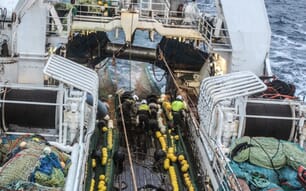Funded by the Seafish Industry Project Fund (IPF), this research tackled the yellowing of haddock, which represents a major problem for the UK seafood industry.
Resolving the problem would potentially protect and make available £45 million of haddock which is currently rejected, says Seafish. This represents around 50 per cent of the total UK haddock market, which was valued at £90 million in 2008. Although yellowing is not harmful, affected fillets take on a distinctive yellow colour, which when cooked turn pink. A tough texture is often associated with yellowing, which makes the fish objectionable to the consumer.
“This research has looked into the reasons behind yellowing. The problem is mainly associated with fish from Russian vessels in the Barents region, although it can occur in fish from other vessels and grounds. Yellowing can occur in both ‘headed and gutted’ (H&G) blocks, in fillet blocks frozen at sea, and when H&G blocks are subsequently reprocessed into fillet blocks ashore. It can be observed in fish caught all year round, and can take from 48 hours to eight months to appear,” said Richard Watson, Seafish Project Manager.
“Many theories have been put forward to explain why this occurs. Generally it is thought to be caused by certain onboard practices. To prove this, trials were carried out at sea and ashore to try and identify the exact cause of the problem,” he said.
Whilst it was not possible to completely replicate the yellowing effect, the trials showed that the yellowing was caused by the by-products of A2 phospholipase enzyme activity, reacting with muscle fibres. For this to occur, cell damage has to take place. It is thought that a combination of factors are responsible, including slow freezing rates, freezing in rigor and undue mechanical pressure from the plate freezer. And higher temperatures will increase the rate of reaction.
“As a result we are able to make a number of recommendations which should help avoid this yellowing effect,” said Richard.
“Plan the catch to avoid fish sitting at higher temperatures on deck. This will speed up the onset of rigor and initial enzyme activity, and could lead to partially frozen blocks if fish is rushed though the freezing process. A partially frozen block will take a long time to freeze completely in the hold and result in major damage to the fish. Freeze the fish quickly to -30°C by maintaining the plate freezers in good working order, and avoid overfilling.
“Finally store the fish at a constant temperature. Below -30°C if practicable. If the blocks are allowed to warm up, enzyme activity will double for every 10°C rise,” he said.
Why Haddock Yellows when Frozen
UK - New collaborative research by Seafish, Youngs Bluecrest and DTU Aqua-National Institute of Aquatic Resources, has explained why some frozen at sea haddock develops a yellow discolouration. A new Seafish fact sheet gives advice on how to avoid this.


